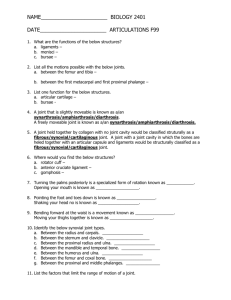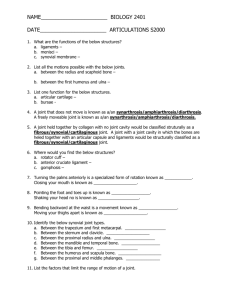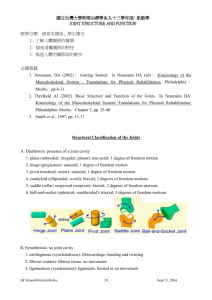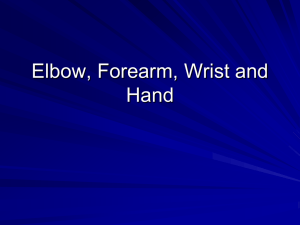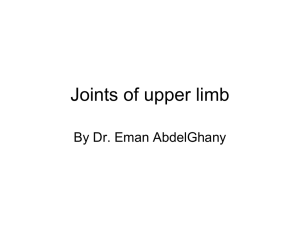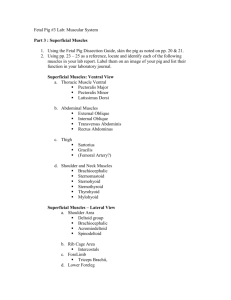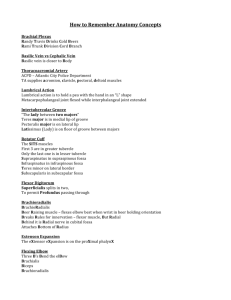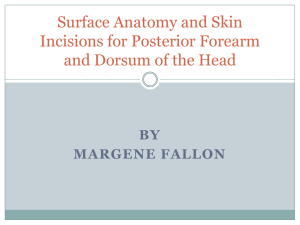Elbow Joint
advertisement
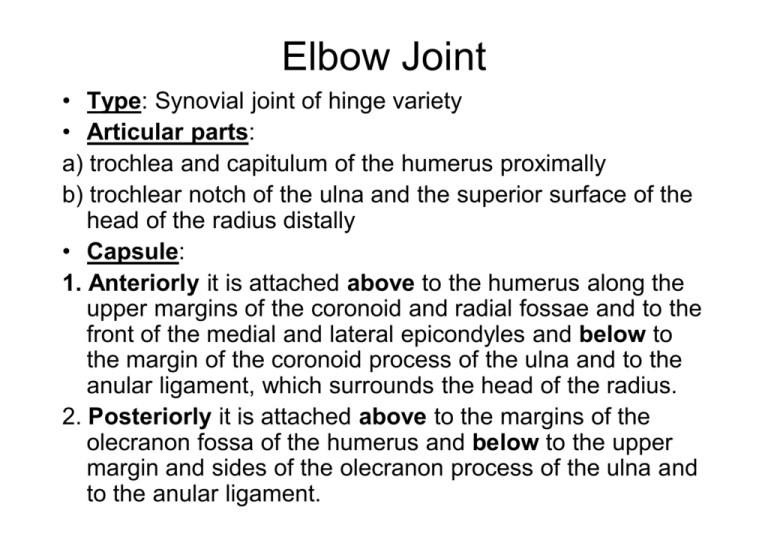
Elbow Joint • Type: Synovial joint of hinge variety • Articular parts: a) trochlea and capitulum of the humerus proximally b) trochlear notch of the ulna and the superior surface of the head of the radius distally • Capsule: 1. Anteriorly it is attached above to the humerus along the upper margins of the coronoid and radial fossae and to the front of the medial and lateral epicondyles and below to the margin of the coronoid process of the ulna and to the anular ligament, which surrounds the head of the radius. 2. Posteriorly it is attached above to the margins of the olecranon fossa of the humerus and below to the upper margin and sides of the olecranon process of the ulna and to the anular ligament. • Ligaments: 1. The lateral ligament is triangular and is attached by its apex to the lateral epicondyle of the humerus and by its base to the upper margin of the anular ligament 2. The medial ligament is also triangular and consists principally of three strong bands: the anterior band, which is attached to the medial epicondyle of the humerus and the medial margin of the coronoid process; the posterior band, which is attached to the medial epicondyle of the humerus and the medial side of the olecranon; and the transverse band, which passes between the ulnar attachments of the two preceding bands. • Synovial membrane: This lines the capsule and covers fatty pads in the floors of the coronoid, radial, and olecranon fossae • Nerve supply: articular branches from the median, ulnar, musculocutaneous, and radial nerves • Movements 1. Flexion is performed by the brachialis, biceps brachii, brachioradialis, and pronator teres muscles. It is limited by the anterior surfaces of the forearm and arm coming into contact. 2. Extension is performed by the triceps and anconeus muscles. It is checked by the tension of the anterior ligament and the brachialis muscle. N.B. The long axis of the extended forearm lies at an angle to the long axis of the arm. This angle, which opens laterally, is called the carrying angle and is about 170° in the male and 167° in the female. The angle disappears when the elbow joint is fully flexed. Relations • Anteriorly: The brachialis, the tendon of the biceps, the median nerve, and the brachial artery • Posteriorly: The triceps muscle, a small bursa intervening • Medially: The ulnar nerve passes behind the medial epicondyle and crosses the medial ligament of the joint. • Laterally: The common extensor tendon and the supinator. Proximal Radioulnar Joint • Type: Synovial joint of pivot variety • Articular parts: 1. the circumference of the head of the radius 2. the anular ligament and the radial notch on the ulna • Capsule: The capsule encloses the joint and is continuous with that of the elbow joint. • Ligament: The anular ligament is attached to the anterior and posterior margins of the radial notch on the ulna and forms a collar around the head of the radius. It is continuous above with the capsule of the elbow joint. It is not attached to the radius. • Synovial membrane: This is continuous above with that of the elbow joint. Below it is attached to the inferior margin of the articular surface of the radius and the lower margin of the radial notch of the ulna. • Movements • The movements of pronation and supination of the forearm involve a rotary movement around a vertical axis that passes through the head of the radius above and the attachment of the apex of the triangular articular disc below. 1. In pronation, the head of the radius rotates within the anular ligament. This movement results in the palm comes to face posteriorly and the thumb lies on the medial side. Pronation is performed by the pronator teres and the pronator quadratus. 2. The movement of supination is a reversal of this process so that the hand returns to the anatomic position and the palm faces anteriorly. Supination is performed by the supinator and biceps brachii (only when the elbow is flexed). Because supination is the more powerful movement, screw threads and the spiral of corkscrews are made so that the screw and corkscrews are driven inward by the movement of supination in right-handed people. Middle radioulnar joint Interosseous membrane • It is a broad, thin, collagenous sheet. Its fibres is directed distomedially between the radial and ulnar interosseous borders. The membrane is deficient proximally, starting distal to the radial tuberosity. • Openings: An oval aperture near its distal margin conducts the anterior interosseous vessels to the back of the forearm. A gap between its proximal border and the oblique cord conducts the posterior interosseous vessels • Functions: 1. The membrane provides attachments for the deep forearm muscles and connects the radius and ulna. 2. Its fibres appear to transmit forces which act proximally from the hand to the radius, thence to the ulna and humerus. Distal Radioulnar Joint • Type: Synovial joint of pivot variety • Articular parts: Between the head of the ulna and the ulnar notch on the radius • Articular disc: This is triangular and composed of fibrocartilage. It is attached by its apex to the lateral side of the base of the styloid process of the ulna and by its base to the lower border of the ulnar notch of the radius. It shuts off the distal radioulnar joint from the wrist. • Synovial membrane: This lines the capsule passing from the edge of one articular surface to the other. • Movements: Pronation and supination of the forearm Wrist Joint (Radiocarpal Joint) • Type: Synovial joint of ellipsoid variety • Articular parts: 1. the distal end of the radius and the articular disc above 2. the scaphoid, lunate, and triquetral bones below • The proximal articular surface forms an ellipsoid concave surface, which is adapted to the distal ellipsoid convex surface. • Capsule: The capsule encloses the joint and is attached above to the distal ends of the radius and ulna and below to the proximal row of carpal bones. • Ligaments: 1. Anterior and posterior ligaments strengthen the capsule. 2. The medial ligament is attached to the styloid process of the ulna and to the triquetral bone 3. The lateral ligament is attached to the styloid process of the radius and to the scaphoid bone • Synovial membrane: This lines the capsule and is attached to the margins of the articular surfaces. The joint cavity does not communicate with that of the distal radioulnar joint or with joint cavities of intercarpal joints. • Movements 1. Flexion by flexor carpi radialis, flexor carpi ulnaris, and palmaris longus. These muscles are assisted by flexor digitorum superficialis, flexor digitorum profundus, and flexor pollicis longus. 2. Extension by extensor carpi radialis longus, extensor carpi radialis brevis, and extensor carpi ulnaris. These muscles are assisted by extensor digitorum, extensor indicis, extensor digiti minimi, and extensor pollicis longus. 3. Abduction by flexor carpi radialis and extensor carpi radialis longus and brevis. 4. Adduction by flexor and extensor carpi ulnaris. Intercarpal Joints • Type: Synovial joints of plane variety • Articulation: Between the individual bones of the proximal row of the carpus; between the individual bones of the distal row of the carpus; and finally, the midcarpal joint, between the proximal and distal rows of carpal bones • Movements: A small amount of gliding movement is possible. Carpometacarpal Joint of the Thumb • Type: Synovial joint of saddle variety • Articular parts: Between the trapezium and the base of the first metacarpal bone • Movements 1. Flexion is the movement of the thumb across the palm. The muscles producing the movement are flexor pollicis longus and brevis and opponens pollicis. 2. Extension is the movement of the thumb in a lateral or coronal plane away from the palm. The muscles producing the movement are the extensor pollicis longus and brevis. 3. Abduction is the movement of the thumb in an anteroposterior plane away from the palm. The muscles producing the movement are abductor pollicis longus and brevis. 4. Adduction is the movement of the thumb in an anteroposterior plane toward the palm. The muscle producing movement is the adductor pollicis. 5. Opposition is the movement of the thumb across the palm in such a manner that the anterior surface of the tip comes into contact with the anterior surface of the tip of any of the other fingers. The movement is accomplished by the medial rotation of the first metacarpal bone and the attached phalanges on the trapezium. The muscle producing the movement is the opponens pollicis. Metacarpophalangeal Joints • Type: Synovial joints of condyloid variety • Articular parts: Between the heads of the metacarpal bones and the bases of the proximal phalanges of medial 4 fingers. • Movements: 1. Flexion: by flexor digitorum superficialis and profundus, the lumbricals and the interossei 2. Extension: by extensor digitorum, extensor indicis, and extensor digiti minimi 3. Abduction: Movement away from the midline of third finger is performed by the dorsal interossei. 4. Adduction: Movement toward the midline of the third finger is performed by the palmar interossei. Interphalangeal joints • Type: Synovial joints of hinge variety • Articular parts: Between the heads and the bases of the adjacent phalanges. • Movements: 1.Flexion: by flexor digitorum superficialis and profundus, the lumbricals and the interossei 2. Extension: by extensor digitorum, extensor indicis, and extensor digiti minimi
